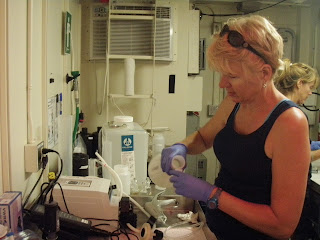The research vessel had a few technical issues this cruise, but everyone pulled together to get the job done. On the fourth day of the cruise, we were looking for a hypoxic but not anoxic area of the bay and thought that they were at one this morning, but not so. Turns out the CTD had not been giving correct oxygen readings and what was thought to be hypoxic turned out to be anoxic. So reading were taken by hand and we "inched" down the bay looking for an area that was hypoxic but didn't have sulfide at the bottom. It took a long time, and we had to redo measurements and tests because of the equipment foul up. Ah well, just more fun in the sun and the lab.
Looks like there are more anoxic areas that expected, but not really considering the amount of runoff into the bay this year. All that runoff brings lots and lots of nutrients into the bay which causes lots and lots of algae growth, which increases zooplankton growth, but not enough to eat it all and when all that algae dies and falls the the bottom of the bay, the bacteria uses up all the oxygen down there decomposing it. That's not all the story though. Cold salt water from the ocean and warm fresh water from runoff set up a density stratification that prevents oxygen from the surface from reaching the bottom of the bay. This is called the pycnocline, and in places in the bay, it is a very sharp change in density from the bottom to the top.
One of the scientists on the cruise has designed a really cool apparatus for pulling water along a very narrow pycnocline to look at water changes in both chemistry and organisms. Daniel Lee has designed a syringe apparatus and is testing it out. Pretty exciting stuff.
Each day of the cruise brought new challenges and learning experiences. Listening the scientists share their work and passion for it was truly amazing. I feel very fortunate to have been a part of this adventure.



No comments:
Post a Comment